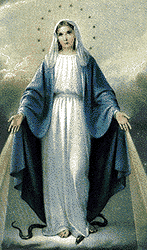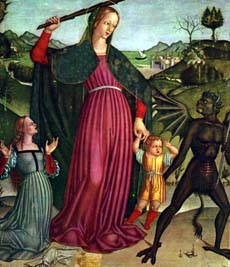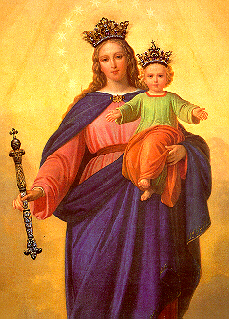VIRGIN MOST POWERFUL:
Catholic Belief in Mary's Strength
-Updated 5/2000
If asked to describe the Blessed Virgin Mary, which adjectives would you use? The list would quite likely include words such as gentle, sweet, humble, tender, etc., since this is how most hymns, sacred art and devotional prayers portray her.
Yes, the Godbearer is all of these things, but she is also courageous, strong, mighty and powerful. Does this sound strange? Then read on.
Mary's Strength in Scripture
The Bible does portray Mary's love, humility and silent contemplation (Lk 1:38; 2:19), traits often held up for imitation by the faithful (particularly women). But her strength, though equally evident in the Gospels, receives little or no attention from commentators.
Miriam of Nazareth is a strong woman who, at the risk of her reputation (Lk 1:34), chooses to bear the Messiah before her marriage with Joseph is finalized. She brings about the first miracle of Jesus' public ministry (Jn 2:1-11) and accompanies her Son to His death, bravely standing (not fainting!) at the foot of the Cross (John 19:25).
She whom the Litany of Loreto invokes as the Queen of Prophets reveals herself to be the Prophetess par excellance when she intones her God-breathed Magnificat:
God has shown the strenth of His arm
and scattered the proud in their conceit.
He has dethroned princes and exalted the lowly
He has satisfied the hungry with good things
and send the rich away empty -Luke 1:51-53
In his encyclical Marialis Cultus, Pope Paul VI comments on this passage:
The modern woman will note with pleasant surprise that Mary of Nazareth, while completely devoted to the will of God, was far from being a timidly submissive woman or one whose piety was repellent to others; on the contrary, she was a woman who did not hesitate to proclaim that God vindicates the humble and the oppressed, and removes the powerful people of the world from their priviledged positions" (1).
 Mother Church identifies Mary with the Woman of Genesis 3:15 whom God said would be the perpetual enemy of the Devil: "I will put emnity between you (the serpent) and the woman, between your seed and her seed. He shall crush your head and you shall crush his heel".
Mother Church identifies Mary with the Woman of Genesis 3:15 whom God said would be the perpetual enemy of the Devil: "I will put emnity between you (the serpent) and the woman, between your seed and her seed. He shall crush your head and you shall crush his heel".
Since the Latin word for "seed" is feminine, the Latin Vulgate translation used a feminine pronoun to refer to the Seed. Thus the Douay Bible (the English translation of the Vulgate) renders the third line as "she shall crush your head" ("she" referring to the seed). Some Catholics interpreted that feminine pronoun as referring to the Woman, and thus perceived Mary as the one who would crush Satan, the ancient Serpent. This is why we often see artistic portrayals of Mary trampling on a serpent.
Although that interpretation of Genesis 3:15 was not entirely accurate, the passage itself still portrays Mary as the bitter enemy of the devil ("I will put emnity between you and the woman"). Nor is it entirely wrong to depict her in art crushing the ancient Serpent, for Saint Paul writes that the entire Church will one day crush Satan underfoot with God's help (Romans 16:30). Mary, the Image and Model of the Church, already enjoys that victory by virtue of her Immaculate Conception. By the power of Jesus Christ her Son she is the triumphant foe of Satan, never his defeated slave.
Judith, the deuterocanonical heroine who saves the Israelites by beheading the enemy general Holofernes, is a prototype of Mary, and the Church attributes to Our Lady the high praises accorded to Judith:
And they all adored the Lord, and said to (Judith): The Lord hath blessed thee by his power, because by thee he hath brought our enemies to naught...Blessed art thou, O daughter, by the Lord the most high God, above all women upon the earth. Blessed be the Lord who made heaven and earth, who hath directed thee to the cutting off the head of the prince of our enemies...Thou art the glory of Jerusalem, thou art the joy of Israel, thou art the honor of our people.
-Judith 13:22-24; 15:10 (Douay)
Mary's identification with the Shulamite in the Song of Songs allowed for the application of such titles as Tower of David (SS 4:4) and Tower of Ivory (7:4) to her. Both of these titles have martial significance, for they portray Mary as a powerful fortress.
"Thy neck is as the tower of David, which is built with bulwarks: a thousand bucklers hang upon it, all the armour of valiant men" -Song of Songs 4:4
"As a tower of ivory, (Mary) is beloved by God and terrible to the Devil" (2).
Turris eburnea, Ivory Tower: thus we call her, for strength of soul is an inseparable characteristic of the Immaculate Virgin at each turning point of her life. Never was anyone more courageous than this woman. Except Christ Himself, the world has never know such delicacy of soul allied with such self-mastering courage. (3)
Songs 6:10 depicts the Shulamite as "terrible as an army set in battle array". Catholics apply this image to the Virgin as well, for her sinless glory is terrifying to the demonic forces (hence the Marian title, Terror of Demons!).
Pope Pius XII extolled her under these titles:
Mary is beautiful in herself as the moon, radiates her brilliance as the sun; but against "the enemy" she is formidable; terrible as an army arrayed for war. As we rejoice and exalt her today, God knows how we would like to forget the difficulties of the times in which we live....There is the "enemy" even at the very doors of the Church, threatening souls. And behold, another aspect of Mary: her power in combat....Mary, sinless, has crushed the head of the corrupting serpent. When Mary approaches, the demon flees - just as darkness dissipates when the sun rises. Where Mary is present, Satan is absent; where the sun shines, there is no darkness (4).
The Strength of Mary in Catholic Devotion
The Brown Scapular of the Carmelite Order has become a very important symbol of devotion to Mary. Yet the scapular is also a symbol of spiritual warfare; it is the "uniform" of the legions of spiritual warriors who fight under the banner of Mary.
The following is an exerpt from a Novena to Our Lady of Mount Carmel:
How strange it seems to think of Mary as a warrior.
The gentle maid of Nazareth, the Virginal Mother, the Mother of the Prince of Peace, is still called -and properly called- "More terrible than army in battle array."
And so she is....
Mary, conqueror of heresies
Mary, triumphant always in the battle with sin.
When then we put on the scapular, which is Mary's uniform, we join in a special way the regiment of which Mary is the queen and honorary colonel.
We pledge ourselves to do battle against the enemy of the human race.
We will be victorious as Mary is victorious, and conquering as Christ is conquering" (5).
Some other Marian titles which express her strength are Virgin Most Powerful (mentioned in the Litany of Loreto) and Our Lady of Victory. The former expresses her powerful intercession, and the latter the fact that she is victorious over all our spiritual enemies and all evil.

Our Lady of Help
The inhabitants of the Sicilian town of Caltavulturo venerate the Madonna as their patroness under the title Our Lady of Help. The traditional image associated with this title is rather intriguing, for Mary is portrayed holding a club in her upraised right hand which she uses to drive away enemies who threaten her children! Those "enemies" could be natural ones, such as invaders seeking to attack the town, or spiritual enemies, as depicted in the painting on the left.
Most of us are probably not used to seeing the gentle Madonna weilding a weapon! But regardless of what one thinks of this picture, one thing is certain:
This is not an image of a weak, timid female!
Our Lady of Help by Giovanni da Monte Rubiano.
For another powerful image of the Blessed Virgin, see this striking Picture of Our Lady of Guadalupe defeating the seven-headed dragon of Apocalypse/Revelation 12.
A reader recently emailed me with additional information about devotion of Our Lady of Help (also called Our Lady of Succor).
She points out that it is not just a Sicilian devotion, but was very common throughout Italy during the 14th and 15th centuries.
It seems to have originated among the Augustinians.
She said that there are numerous paintings of Our Lady of Succor, and that the one above depicts a particular miracle: A mother was so angry at her child that she cried: "May the devil take you away!".
Suddenly the devil appeared and snatched the child. The poor mother, repenting and regretting, asked for help from Our Lady of Succor, who appeared and delivered the child.
I am very grateful for this new information!

In northern Italy about 200 years ago, Saint John Bosco promoted devotion to Mary Help of Christians (another title drawn from the Litany of Loreto). His own prayer to her expresses the power and authority of the Mother of God under this title:
Mary, most powerful Virgin,
You are the mighty and glorious Protector of the Church.
You are the marvelous Help of Christians.
You are awe-inspiring as an army in battle array.
You have destroyed heresy in the world.
In the midst of our anguish, our struggle and our distress
defend us from the power of the enemy,
and at the hour of our death receive our soul into heaven. Amen. (6)
Note all the references to powerful Marian titles mentioned above - most powerful Virgin, terrible as an army, Destroyer of heresies, etc.
Commenting on the title "Help of Christians", Saint Alphonsus de Liguori writes:
Saint John Damascene call Mary "the prepared and always ready help of Christians, by which they are delivered from dangers". The help of Mary is, as St. Cosmas of Jerusalem writes, "all-powerful to deliver us from sin and hell." St. Bernard, addressing Mary, says, "Thou art an invincible warrior in defence of thy servants, fighting against the devils who assail them." (7)
Conclusion
This selection of Marian titles and devotions should sufficiently prove that the Blessed Virgin is no helpless weakling. She possesses and exemplifies feminine strength, which fights and conquers evil and protects dependents, such as children. In the Virgin most Powerful, all women can find a model of personal strength and fortitude, to balance out the example of receptivity and silent contemplation. All of these virtues have an important place - for both women and men! - in the Christian life.
Return To Top
WORKS CITED
- Paul VI (1974) Marialis Cultus, paragraph 37.
- Rupert of Deutz, quoted in The Glories of Mary, page 631.
- Leon Joseph Suenens, The Theology of the Apostolate, (Chicago: Regnery, 1953) 49-50.
- Pius XII, Talk given on 8 December 1953.
- Daniel A. Lord, SJ., _Mount Carmel Novena_, copyright 1947, p. 3.
- John Bosco, "Prayer to Mary Help of Christians"
- Alphonsus de Liguori, The Glories of Mary, (Brooklyn: Redemptorist, 1931) 637.
Picture of Our Lady Help of Christians from Devotos de María Auxiliadora (http://sparc.ciateq.conacyt.mx/~maria/). Thanks to Auxiliadora García Bellorín for letting me use the jpeg.

Tell A Friend About This Site!
| Return To Top | Next Article | Marian Index | Site Index | Home Page |

 Mother Church identifies Mary with the Woman of Genesis 3:15 whom God said would be the perpetual enemy of the Devil: "I will put emnity between you (the serpent) and the woman, between your seed and her seed. He shall crush your head and you shall crush his heel".
Mother Church identifies Mary with the Woman of Genesis 3:15 whom God said would be the perpetual enemy of the Devil: "I will put emnity between you (the serpent) and the woman, between your seed and her seed. He shall crush your head and you shall crush his heel".
